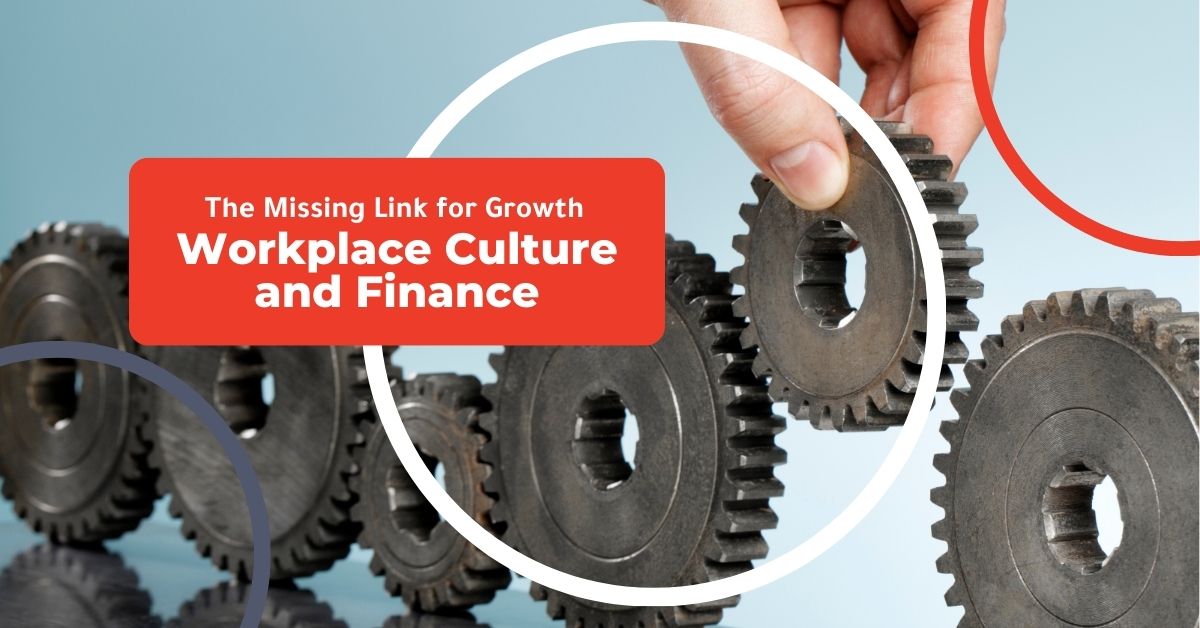Workplace Culture and Finance: The Missing Link to Growth
Jul 24, 2024
Understanding workplace culture and finance is essential for achieving your business’s goals. When you align your company’s culture with its financial objectives, employees become more engaged and motivated. This balance creates purpose and drives productivity. A positive culture ensures everyone understands their roles, collaborates effectively, and feels valued.
Leaders contribute to shaping this culture by being transparent and modeling behaviors they want to see. A supportive environment built on cooperation, collaboration, contribution, and community forms a strong foundation. This integration leads to financial success and enhances employee satisfaction.
Integrating Culture and Finance for Organizational Success
Organizational Culture and Financial Impact
Integrating workplace culture and finance is often overlooked but essential for success. When these elements align, employees become more motivated and productive, leading to increased financial performance. A positive culture aligns employee goals with company objectives, making everyone feel valuable and contributing effectively to the bottom line.
Most employees simply don’t understand the nuances of finance – nor is it their job to. But clear communication about how daily tasks affect the company’s financial health ensures employees understand this connection. This awareness encourages efficient practices. For instance, if the marketing team knows that reducing costs can improve profit margins, they’ll be inclined to budget more carefully.
- Financial Literacy Training: Include financial literacy in onboarding and ongoing training to help employees understand financial details.
- Regular Financial Updates: Hold meetings to present financial updates, ensuring employees understand their impact on the company’s finances.
- Feedback Loops: Create channels for discussing and refining financial strategies based on employee input.
Leadership’s Role in Shaping Culture
Leaders, especially CFOs, are critical in embedding desired behaviors and nurturing a supportive environment. Demonstrating transparency, integrity, and empathy sets a positive tone within the workforce.
An open-door policy makes leaders accessible, encouraging employees to share ideas and concerns. Regular check-ins can bridge the gap between strategic decisions and day-to-day operations, making employees feel involved.
Discussing both successes and challenges builds trust. For example, explaining the financial reasons behind budget adjustments helps employees understand the broader business context, fostering an inclusive and informed environment.
- Share Financial Insights: Regularly update employees about the company’s financial status and the reasoning behind decisions.
- Encourage Feedback: Listen to employee feedback and act on feasible suggestions.
- Recognize Contributions: Regularly reward contributions that align with company goals.
Components of a High-Performance Culture
Building a robust organizational culture involves focusing on the “Four Cs”: Cooperation, Collaboration, Contribution, and Community. These components are essential for effectively integrating workplace culture and finance.
Cooperation
Cooperation thrives with clearly communicated roles, responsibilities, and expectations. Joint goal-setting sessions emphasize mutual objectives and collective responsibility, ensuring alignment throughout the team.
Collaboration
A collaborative environment leverages diverse strengths and fosters innovation. Encourage cross-departmental projects to help employees achieve common goals. Structured programs recognizing teamwork promote a cooperative spirit.
Contribution
Make sure every role within the company is valued. Regular feedback and performance assessments show how employees’ work supports company objectives, keeping them committed and engaged.
Community
Fostering a sense of community boosts morale and unity. Organizing events and team-building activities encourages personal connections. A united team is more motivated and focused on achieving common goals.
Building a Culture of Open Communication and Continuous Feedback
Valuing Employee Contributions
Every employee’s contribution is essential for your success. Transparent communication helps employees understand their impact on the organization, and knowing how their efforts align with business goals increases their engagement and motivation.
Here are ways to ensure employees feel integral to the company:
- Celebrate Achievements: Acknowledge accomplishments publicly during team meetings or through internal newsletters.
- One-on-One Meetings: Regularly conduct individual check-ins to discuss victories, challenges, and future aspirations.
- Recognition Programs: Implement “Employee of the Month” projects to reward outstanding performance.
Transparent communication clarifies the direct impact of each employee’s work on company achievements. This clarity builds pride and shows the importance of each team member in the organization’s success.
Opportunities for Feedback and Engagement
Ongoing feedback channels are another key for employee engagement. Combining structured and informal feedback opportunities promotes open dialogue, leading to actionable improvements and innovation.
Structured Feedback Sessions
Regular reviews, surveys, and focus groups provide actionable feedback channels, giving employees consistent opportunities to voice their concerns and suggestions.
- Online Surveys: Collect honest feedback anonymously for straightforward insights without fear of repercussions.
- Quarterly Focus Groups: Organize discussions to gather focused input on specific areas for improvement.
- Regular Manager Check-ins: Hold monthly meetings to review goals, track progress, and address concerns.
Informal Interactions
Informal settings help employees feel more comfortable sharing insights. Regular social gatherings, team lunches, and casual meetings encourage open conversations. When we share space with co-workers away from daily responsibilities, we build a rapport that translates into making communication at work easier and faster.
- Team-Building Activities: Organize events to promote open dialogue and break communication barriers. These don’t need to be elaborate, expensive trips or parties.
- “Lunch and Learn” Sessions: Use informal lunches to discuss topics of interest in a relaxed setting.
Combining structured feedback mechanisms with informal interactions captures many insights, leading to a more responsive and adaptable organization.
Communicating Financial Insights Simply
Clear communication about financial matters ensures everyone understands their role in achieving company goals. Simplifying financial concepts helps non-financial staff grasp the impact of their contributions.
Here are a few strategies for making financial communication more digestible:
- Visual Financial Reports: Use charts and graphs to represent complex financial data, making key metrics easier to understand.
- Cross-Department Workshops: Host sessions where finance professionals explain financial concepts and how different departments contribute to the company’s financial health.
- Regular Financial Updates: Share concise financial performance updates in meetings and newsletters.
- Relatable Analogies: Use simple, real-world comparisons to explain financial concepts, making them accessible to everyone.
When employees understand the financial aspects of their work, they are better equipped to make decisions that align with company goals. This clarity promotes shared responsibility and unites the team toward common objectives.
Empowering Employees through Leadership and Strategic Initiatives
Encouraging Leadership by Example
Leaders who exemplify desired behaviors and values enhance employee engagement and performance. They set clear standards and encourage a cohesive environment of mutual respect and shared goals.
One effective strategy is promoting an open-door policy, ensuring leaders are accessible. This encourages the sharing of ideas and concerns, bridging the gap between strategic intentions and daily operations. Regular one-on-one meetings provide personal connections, helping leaders understand individual aspirations and address issues.
Transparency is also important. Leaders should share successes and challenges, creating a problem-solving mindset within the organization. By discussing obstacles and how they overcame them, leaders demonstrate resilience. For example, explaining the financial aspects of a challenging project highlights how employee efforts were crucial in reaching a solution.
Long-Term Commitment to Workforce Development
Promoting a long-term perspective on employee growth helps develop buy-in. Employees become more enthusiastic and dedicated when they see clear paths for advancement. A culture that supports continuous development aligns with organizational goals.
Mentorship programs can be effective. Pairing new employees with experienced colleagues provides guidance and promotes a sense of belonging. Regular professional development opportunities, such as workshops and certifications, help employees expand their skills as needed by the company.
Recognizing and valuing employee contributions is essential for retention. Regular performance reviews that assess and celebrate achievements highlight the company’s appreciation. And informal recognition programs maintain high morale and loyalty.
- Clear Career Paths: Communicate advancement opportunities clearly.
- Continuous Training: Offer regular training programs to help employees acquire new skills and enhance existing ones.
- Work-Life Balance: Support balanced lifestyles with flexible working arrangements and wellness programs.
Cultivating a Cohesive and Adaptive Workplace Culture
Aligning workplace culture and finance has numerous benefits. It creates a unified environment where employees are more productive and satisfied, leading to financial success. A balanced culture also promotes creativity and responsiveness.
Open communication and continuous feedback are essential for building an inclusive atmosphere. These practices ensure long-term success by making everyone feel valued and connected. Inclusive and transparent efforts create an adaptive culture where employees commit to company goals.
Effective leadership blends culture with financial objectives. Leaders should consistently engage and inspire employees, emphasizing adaptation and inclusion to develop a resilient and unified workforce.


